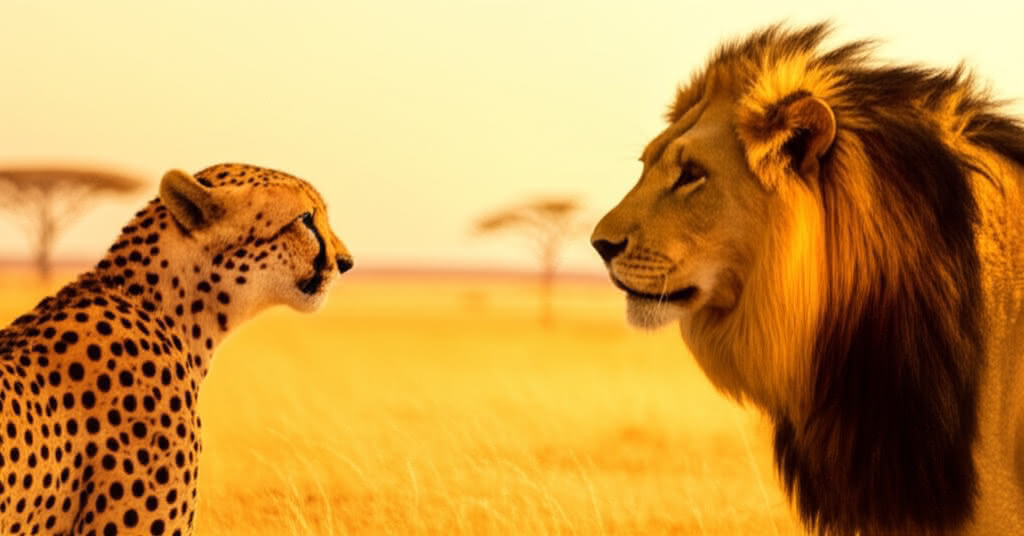Cheetahs vs Lions: A Guide to Africa's Most Famous Big Cats

Cheetahs vs Lions: Unpacking the Differences Between Two Apex Predators
The debate of cheetahs vs lions often conjures images of two of Africa's most iconic predators, but these magnificent animals couldn't be more different. While both are formidable hunters sharing the same savanna, their evolutionary paths have led to unique skills, social structures, and physical traits. This article breaks down the essential differences to help you appreciate what makes each of these big cats a master of its domain.
Physical Showdown: Speed vs. Strength
When comparing these African predators, the most striking contrast lies in their physical abilities. One is a master of velocity, the other a titan of power.
The Cheetah: Built for the Chase
The cheetah is the undisputed fastest land animal on Earth, a title earned through millions of years of specialized evolution. Its body is a marvel of aerodynamic engineering.
- Unmatched Speed: Capable of reaching speeds up to 75 mph (120 km/h) in short bursts, the cheetah uses its acceleration to catch fast-moving prey like gazelles and impalas.
- Specialized Anatomy: A flexible spine, long flat tail for balance, and semi-retractable claws that act like running spikes all contribute to its incredible sprinting ability.
- Lightweight Frame: Cheetahs are slender and lightweight, typically weighing only 77 to 148 pounds (35-67 kg), which sacrifices brute strength for agility and speed.
The Lion: The Embodiment of Power
The lion, often called the "king of the jungle," relies on raw strength and collaborative effort rather than speed. Its build is designed for combat and taking down large, powerful prey.
- Incredible Strength: A male lion can weigh over 500 pounds (225 kg) and is built with dense muscle, especially in its forelimbs, neck, and jaw. This power is essential for wrestling large animals like buffalo and wildebeest to the ground.
- Powerful Roar: A lion's roar can be heard up to 5 miles (8 km) away. It's not just for show—it's used to communicate with pride members and intimidate rivals. Cheetahs cannot roar; they purr, chirp, and hiss instead.
A Tale of Two Lifestyles: Hunting and Social Structure
Beyond their physical differences, the daily lives and hunting methods of cheetahs and lions are worlds apart.
-
Social Life: Lions are the only truly social cats, living in groups called prides. A pride typically consists of related females, their offspring, and a few adult males. This social bond is crucial for hunting, raising cubs, and defending territory. In contrast, cheetahs are largely solitary. Females raise their cubs alone, and males may live alone or form small groups (coalitions) with their brothers.
-
Hunting Strategy: A cheetah's hunt is a dramatic, high-stakes sprint. It will stalk its prey, getting as close as possible before launching into a blistering chase that is over in less than a minute, win or lose. Lions, however, are strategic ambush predators. They use teamwork, stealth, and patience, often surrounding their prey or driving it towards other hidden pride members.
-
Diet and Competition: Due to their smaller size, cheetahs hunt medium-sized prey. Unfortunately, their hard-earned kills are often stolen by larger predators like lions and hyenas. Lions, with their superior strength and numbers, can hunt much larger animals and are dominant at kill sites, rarely facing challenges from other predators.
Fun Facts and Common Questions
- Who would win in a fight between a cheetah and a lion? In a direct confrontation, a lion would win almost every time. Its size, strength, and powerful bite are simply too much for the lightweight cheetah to handle.
- Are cheetahs and lions endangered? Both face significant threats. Cheetahs are listed as "Vulnerable," with only around 7,000 left in the wild, threatened by habitat loss and human-wildlife conflict. Lions are also listed as "Vulnerable," with their populations declining for similar reasons.
- Can a cheetah climb trees? Yes! Cheetahs are excellent climbers and often drag their kills up a tree to keep them safe from scavengers, much like leopards do. While lions can climb, they are less agile and typically only do so if necessary.
How We Analyze These Big Cats
To provide a clear and accurate comparison, our analysis is based on established zoological data and field research. We focus on four key pillars to understand the fundamental differences between these species.
We consider the following aspects:
- Physical Attributes: Analyzing anatomy, weight, and specialized features like claws and skeletal structure.
- Social Behavior: Examining group dynamics, from the solitary nature of the cheetah to the complex prides of lions.
- Hunting Techniques: Contrasting the high-speed chase with the cooperative ambush.
- Conservation Status: Highlighting their place in the ecosystem and the threats they face from human activity.
Conclusion
While they may share the African savanna, the comparison of cheetahs vs lions reveals two vastly different masters of survival. The cheetah is a specialized sprinter, a marvel of speed and agility, while the lion is a powerhouse of strength and social cooperation. Each is perfectly adapted to its niche, playing a vital role in its ecosystem. Understanding their differences not only deepens our appreciation for these incredible animals but also underscores the importance of conservation efforts to protect them both.
To learn more about big cat conservation, consider supporting organizations like the Cheetah Conservation Fund or National Geographic's Big Cats Initiative.
You might also like
Cat Years to Human Years: The Ultimate Guide to Your Feline's Age
Curious about your cat's age? Our guide breaks down cat years to human years, explaining the science behind the calculation and what each life stage means for your pet.
🐾 Weird Wheels: The Curious Case of Animal Speed
From sprinting lizards to slothful salamanders, discover the surprising speeds of some of the world’s weirdest animals.